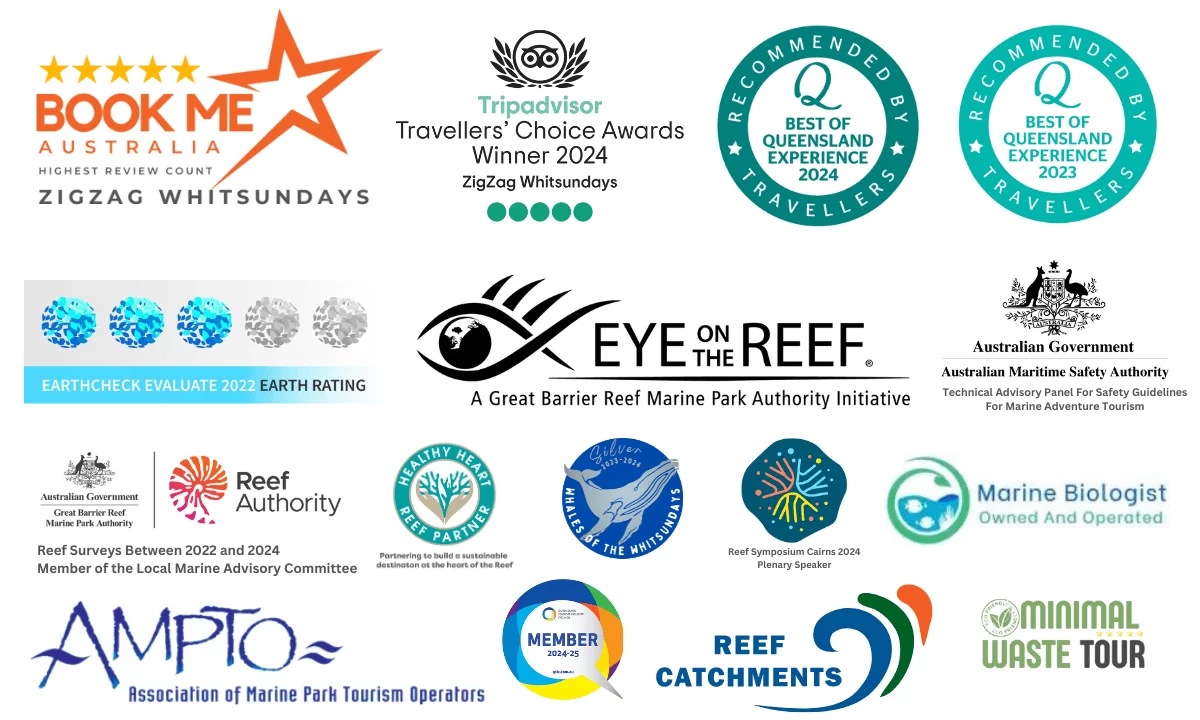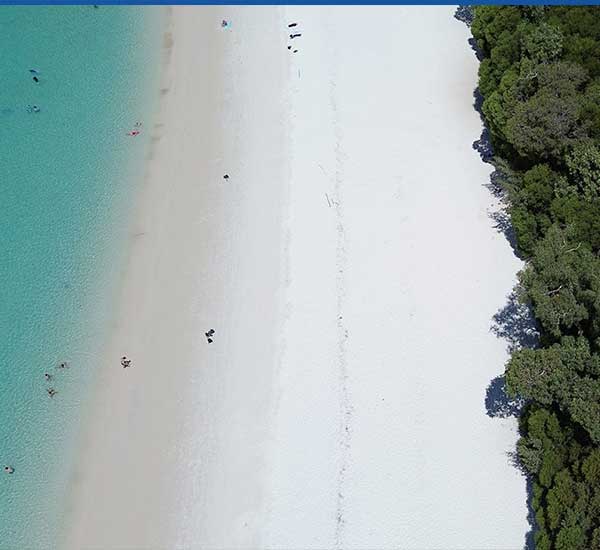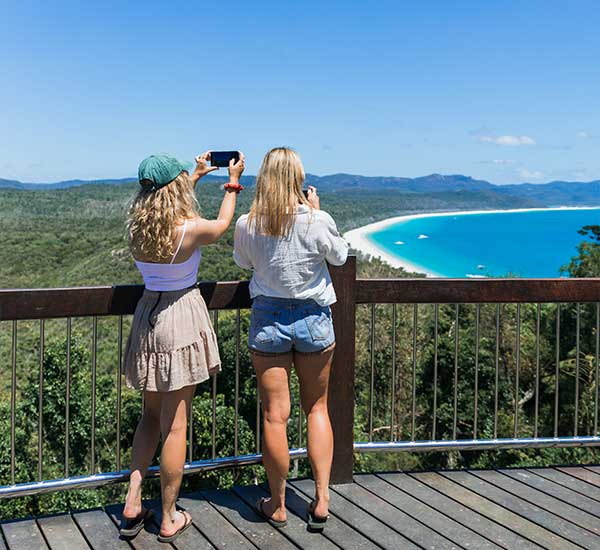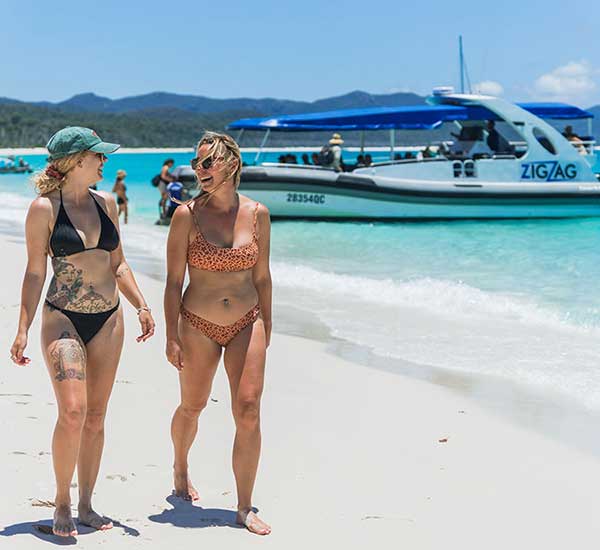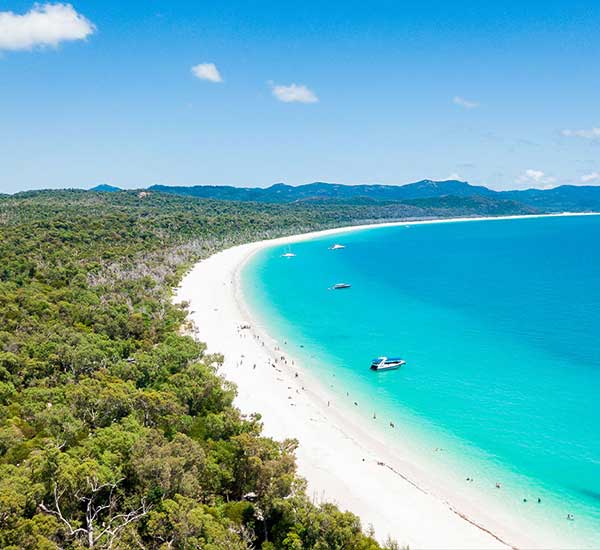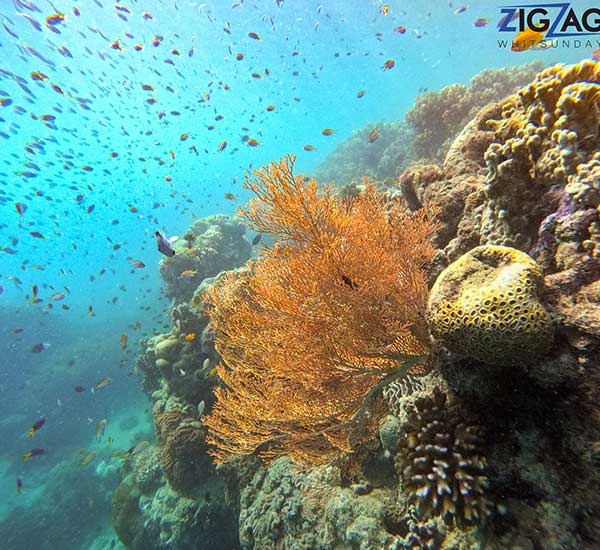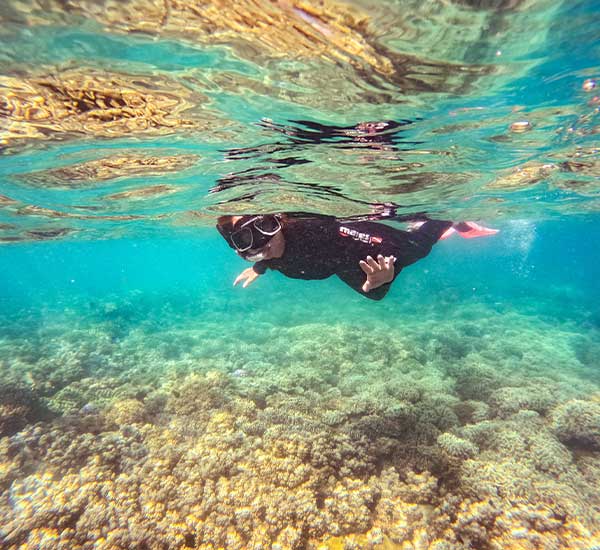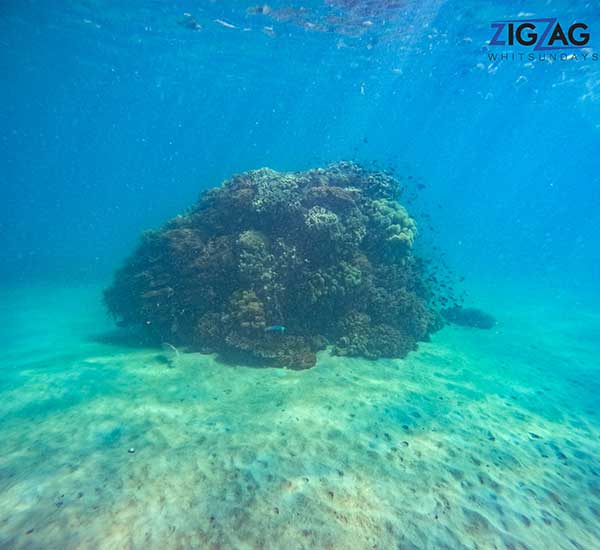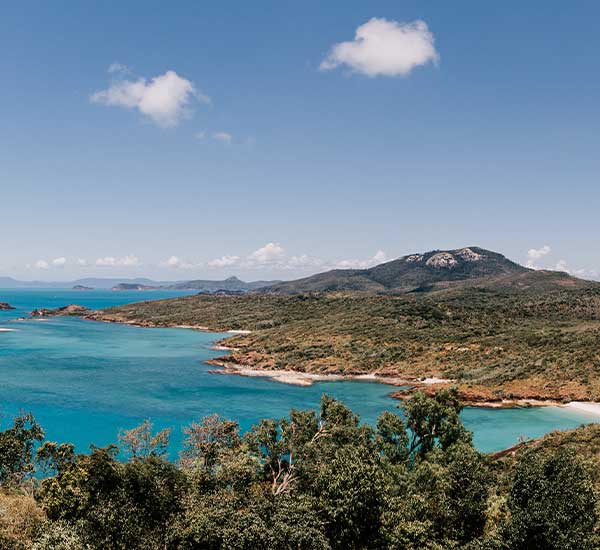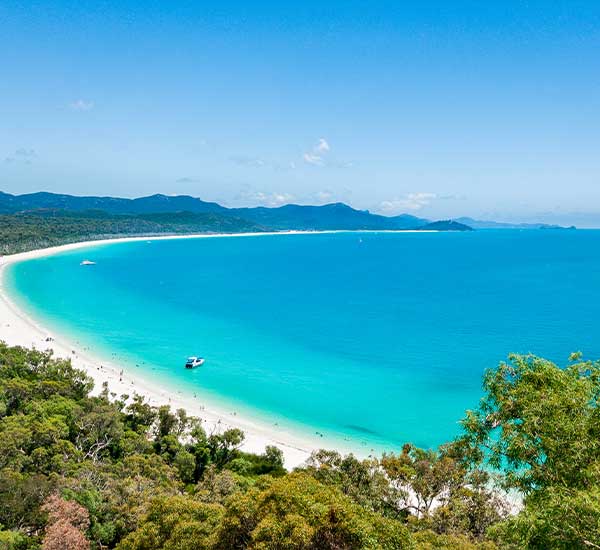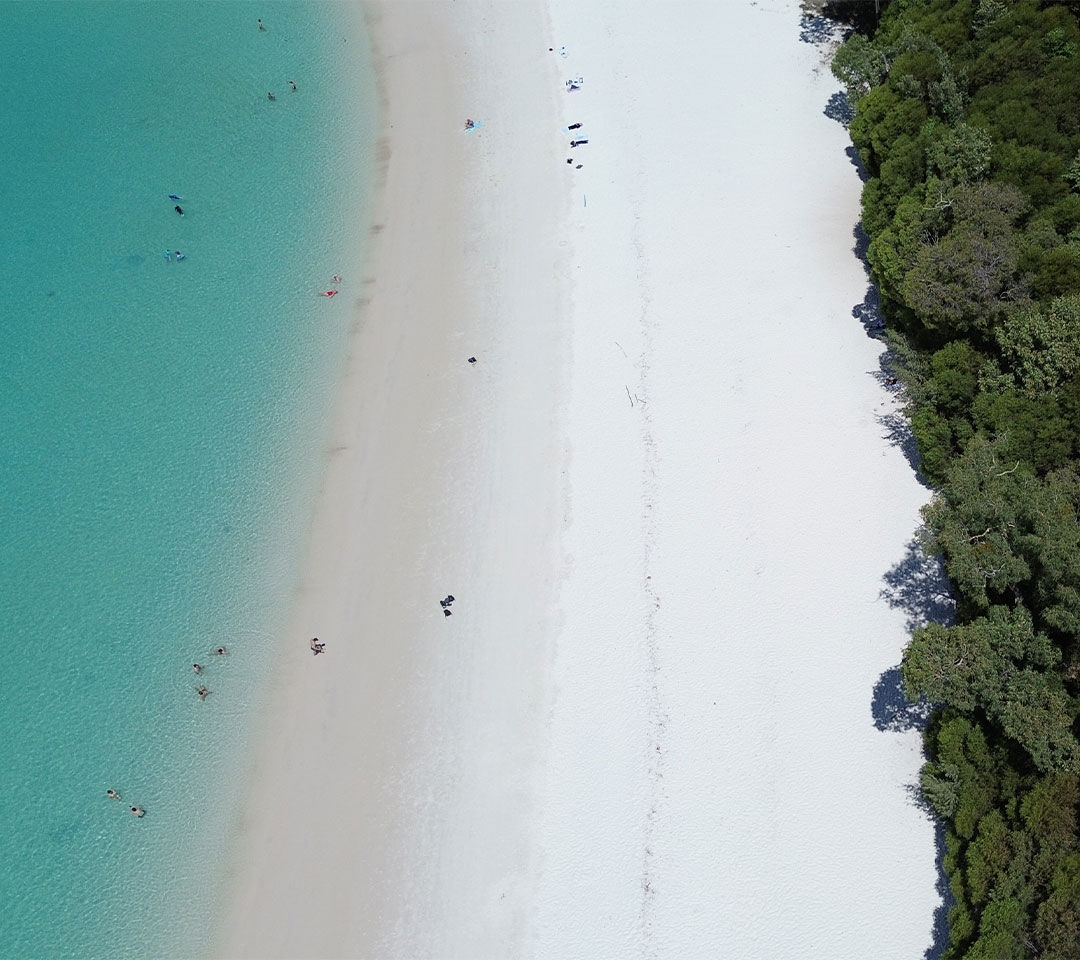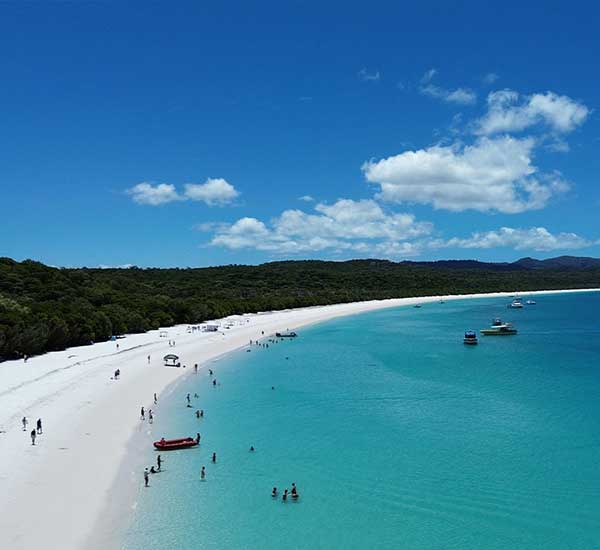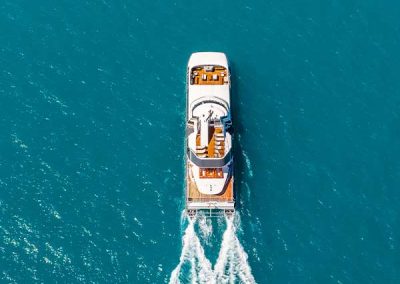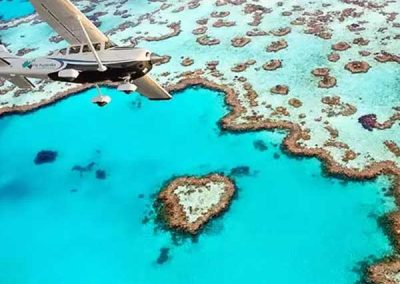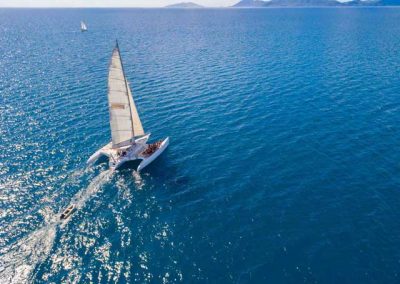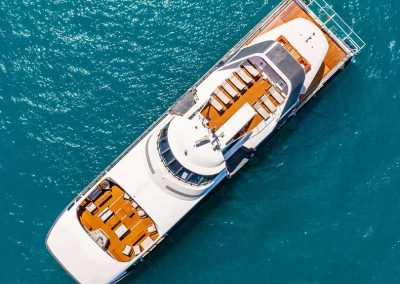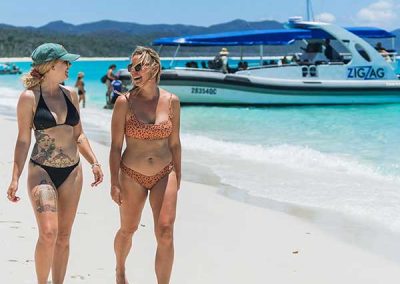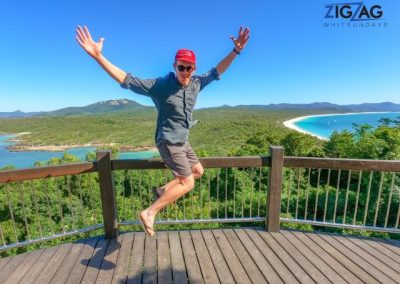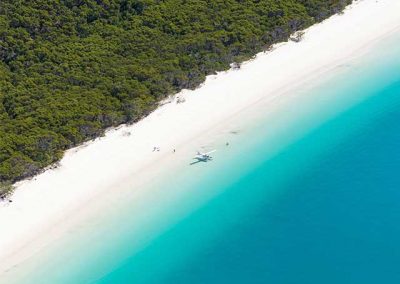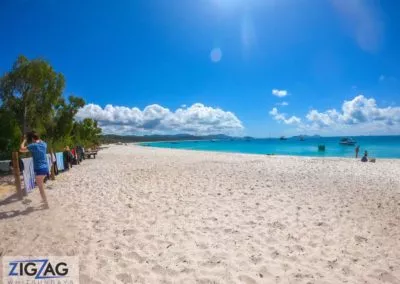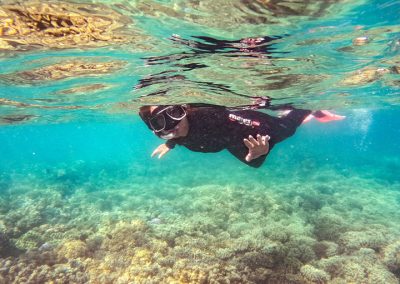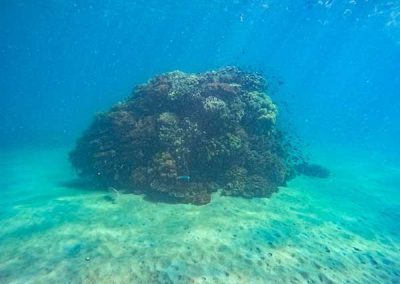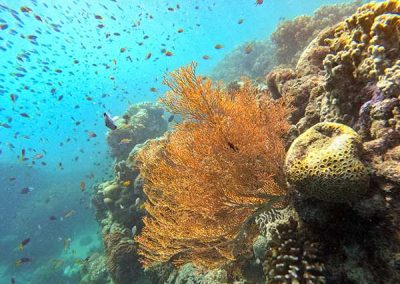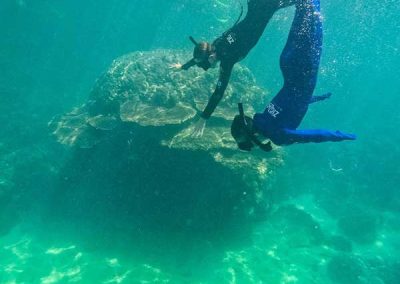Whitehaven Beach Australia – The Full Guide
© ZigZag Whitsundays Official Website
There are beautiful beaches, and then there’s Whitehaven.
Tucked away on Whitsunday Island in Queensland’s far north, Whitehaven Beach is a place that seems to defy reality, a seven-kilometre stretch of dazzling white silica sand lapped by crystal-clear turquoise water. It’s the kind of beach that doesn’t just feature on postcards, it sets the global standard for them. Repeatedly voted one of the best beaches in the world, Whitehaven isn’t just a destination, it’s a benchmark.
What makes it so special? It’s not just the sand (although that’s 98.9% pure silica, which is rare). It’s the way the tides swirl through Hill Inlet at the northern tip, painting the landscape in patterns that seem too perfect to be natural. It’s the complete lack of development, no resorts, no restaurants, no noise, just nature, exactly as it’s meant to be. And it’s the journey to get there, by fast boat, yacht, or scenic flight, that makes arriving feel like you’ve discovered a secret, even though thousands visit every year.
This guide will take you beyond the brochures. From geology and marine life to cultural stories, tour tips, and rarely covered facts, here’s everything you didn’t know you needed to know about Whitehaven Beach.
Where Is Whitehaven Beach?
Whitehaven Beach is located on the eastern shore of Whitsunday Island (view map here), the largest island in the group of 74 islands between the Queensland coast and the outer Great Barrier Reef.
Despite being world-famous, Whitehaven remains isolated 35km offshore of Airlie Beach. There are no roads, no ferry terminals, and no resorts. It sits inside the Whitsunday Islands National Park and is part of the Great Barrier Reef Marine Park, which means access is tightly regulated to preserve its pristine ecosystem.
To visit, you’ll need to depart from either:
- Airlie Beach (mainland hub for the Whitsundays)
- Hamilton Island (for resort guests and luxury day-trippers)
Most visitors reach Whitehaven by:
- Fast boat tours (like ZigZag Whitsundays – great for full-day experiences)
- Sailing tours (like Prosail multi-day options, anchoring overnight near the beach)
- Scenic flights (like Fly Australia Charters, who also fly over Heart Reef)
There are two Lookout (Viewing Platforms), Hill Inlet Lookout, sits at the northern end of the beach, overlooking the swirling sands and shifting blues that define Whitehaven’s identity. This area is best accessed via Tongue Bay, where most commercial boats drop anchor before guests hike up to the lookout.
At the southern end, a second walking trail leads to the South Whitehaven Lookout, offering sweeping views back across the entire stretch of beach and out toward the surrounding islands. It’s a less crowded alternative with a broader vantage, and a feature included on tours like ZigZag Whitsundays.
What Makes Whitehaven Beach So Special?
There’s no shortage of beautiful beaches in Australia, but Whitehaven isn’t just another pretty patch of sand. What sets it apart is a mix of natural rarity, careful preservation, and the kind of serenity you only get in places that take a bit of effort to reach.
The first thing you notice is the sand. It’s almost unreal, blindingly white, powder-soft, and cool underfoot, even on a hot day. That’s because it’s composed of 98.9% pure silica, a geological fluke that gives the beach its signature brightness and fine texture.
Then there’s the colour of the water. Depending on the time of day, tide, and angle of the sun, the sea shifts from glassy turquoise to vivid cobalt. At Hill Inlet, where the beach curves sharply into a tidal estuary, these colours swirl across the sandbanks.
But Whitehaven’s magic goes beyond the visuals. The entire beach is protected within the Whitsunday Islands National Park and Great Barrier Reef Marine Park, which means there are no buildings, no cafes, and no jetties. Everything is left as nature intended. Boats can’t even drop anchor directly on the beach; guests are brought ashore by tender, keeping the marine environment as undisturbed as possible.
Even when the beach is busy, it never feels crowded. With seven kilometres of uninterrupted shoreline, you can always find a patch of sand to claim as your own. And whether you’re swimming, sunbathing, hiking to one of the lookouts, or simply sitting still and taking it all in, Whitehaven has a way of making you slow down and appreciate the world we live in.
Best Ways to Get to Whitehaven Beach
There are no roads leading to Whitehaven Beach, and that’s exactly why it’s stayed so unspoiled. Reaching it requires a bit of planning, but that’s part of the adventure. Whether you’re looking for speed, style, or scenery, there’s more than one way to get there.
Fast Boat Tours from Airlie Beach
The most popular option is a high-speed day tour from Airlie Beach. These boats get you there quickly, giving you more time on the sand and less time in transit. Tours like ZigZag Whitsundays offer 2 ticket options on the same tour, Ticket one – All day Whitehaven Beach (no snorkelling). Ticket 2 – Whitehaven Beach Plus Snorkelling
Sailing Adventures
For something slower-paced, overnight sailing tours let you sleep under the stars and wake up moored near Whitehaven’s shore. These multi-day trips usually include snorkelling, island visits, and plenty of beach time. It’s a favourite among backpackers, photographers, and travellers who want the full Whitsundays experience.
Scenic Flights
If you want to see the bigger picture, seaplanes and helicopters from Airlie Beach or Hamilton Island offer aerial views of Whitehaven Beach, Hill Inlet, and even Heart Reef. Flights can be added to boat tours as a combo package or booked as standalone trips. It’s not the cheapest option — but it’s hard to beat for sheer wow factor.
Private Charters & Transfers
For groups or special occasions, private charters offer a custom experience. You’ll set the pace, choose the route, and often enjoy exclusive beach time away from the tour crowds.
If you would like to know more, I have a full guide on how to get to Whitehaven Beach here
Distances and Travel Time to Whitehaven Beach
How far is Whitehaven Beach from Hamilton Island?
Whitehaven Beach is approximately 10 km from Hamilton Island. By boat, it takes around 30 to 35 minutes, depending on sea conditions and vessel speed.
How far is Whitehaven Beach from Daydream Island?
Whitehaven Beach is about 17 km from Daydream Island. Travel time by boat is typically 40 to 50 minutes on a high-speed vessel.
How far is Whitehaven Beach from Hayman Island?
Whitehaven Beach is roughly 32 km from Hayman Island. The trip usually takes around 60 to 75 minutes by boat, depending on weather and route.
How far is Whitehaven Beach from Airlie Beach?
Whitehaven Beach is approximately 35 km from Airlie Beach by sea. Fast boat tours generally take 60 to 75 minutes, depending on the vessel and sea conditions.
Things to Do at Whitehaven Beach
Whitehaven might be all about the sand and sea, but there’s more to do here than just lay out a towel.
Swim in Crystal-Clear Water
The water here is usually calm, warm, and remarkably clear, ideal for a refreshing swim. There are no stingers or jellyfish nets on the beach itself, so during stinger season (November to April), most tours provide protective suits to swim safely.
Walk to a Lookout
If you’re visiting with a guided tour like ZigZag Whitsundays, you’ll get the chance to visit South Whitehaven Lookout, which offers a rewarding panoramic view across the length of the beach and nearby islands. Hill Inlet Lookout, located at the northern end, is the most famous but also the most crowded, offering sweeping views of the swirling sandbars.
Snorkel Fringing Reefs
While the beach itself isn’t a snorkelling hotspot, many tours combine a visit to Whitehaven with a stop at one of the nearby fringing reefs. These shallow coral gardens are home to colourful fish, rays, and occasionally turtles, and they’re only accessible by boat.
Go Beachcombing
There’s something satisfying about walking the shoreline here. You won’t find many shells or debris, the sand is so fine and light that it filters most of that out, but the occasional piece of coral or driftwood adds to the beach’s natural character.
Sit Still and Do Nothing
Honestly? That’s part of the appeal. No phone reception, no noisy crowds, no flashing signs, just the sound of waves, the crunch of sand underfoot, and the open sky above. If there’s ever a place made for switching off, this is it.
Best Lookouts at Whitehaven Beach
Whitehaven’s beauty is undeniable at ground level, but for the full effect, you’ll want to see it from above. The two main lookouts — one at the northern end and one at the southern end each offer a very different perspective of the beach.
South Whitehaven Lookout
Opened in 2019, the South Whitehaven Lookout is a lesser-known gem at the opposite end of the beach. A 1-kilometre walking track through native bushland leads to a panoramic viewpoint overlooking the full length of Whitehaven Beach, with Chance Bay and surrounding islands in the distance.
It’s a quieter, broader view, perfect for capturing the scale of the coastline without the crowds. Tours like ZigZag Whitsundays include a guided walk to this lookout as part of their full-day itinerary, and it’s well worth the climb.
Whether you choose one or both, the lookouts offer a rare perspective on a place that already feels unreal from sea level.
Hill Inlet Lookout
Located at the northern tip of Whitehaven Beach, this is the spot you’ve probably seen in every postcard and drone video. From the top, you’ll get a clear view of Hill Inlet, where the tide pushes turquoise water across the silica sandbanks, creating the swirling patterns Whitehaven is famous for. The lookout is accessed via a short uphill walk from Tongue Bay, where most tour boats anchor.
The colours and patterns shift with every tide, so no two visits look exactly the same.
Marine Life & Ecosystem
While Whitehaven Beach is known for its sand and scenery, it’s also part of one of the most biologically diverse marine regions on the planet, the Great Barrier Reef Marine Park.
The waters surrounding Whitsunday Island are home to an array of sea life. On calm days, it’s not unusual to spot green turtles, stingrays, or even a reef shark gliding close to shore. Most of the coral and reef life is concentrated just offshore, especially around fringing reef systems found near Whitehaven Beach, including Chalkie’s Beach, and other nearby snorkel stops that many tour operators include in their itinerary.
Below the surface, you’ll find a mix of hard and soft corals, anemone gardens, giant clams, and hundreds of species of reef fish. The visibility is often best in the cooler months (May to September), when rainfall is low and the water is clear and calm.
Above the waterline, the island’s interior is home to native birds, monitor lizards, and tropical vegetation, all protected as part of the Whitsunday Islands National Park. Strict environmental rules are in place to keep the area as untouched as possible, which means no fishing, no feeding wildlife, and no collecting shells or coral.
If you’re travelling with an eco-concious operator like ZigZag Whitsundays, you’ll also get insight into the reef’s health, the threats it faces, and what’s being done to protect it for the future.
History & Indigenous Culture
Long before the yachts and day tours arrived, Whitsunday Island was home to one of the oldest continuous cultures in Australia, the Ngaro people. Known as the “Saltwater People,” the Ngaro lived throughout the Whitsundays for thousands of years, navigating between the islands in bark canoes, fishing the reef, and trading with neighbouring groups along the coast.
Whitehaven Beach and the surrounding island would have played an important role in their seasonal movements. Archaeological evidence, including rock art, shell middens, and stone tools, has been discovered throughout the region, indicating a profound cultural and spiritual connection to the land and sea.
Today, several areas around the Whitsundays form part of the Ngaro Sea Trail, a joint effort between Traditional Owners and Queensland Parks to recognise and preserve the cultural heritage of the islands. It’s important to acknowledge that these lands are part of a broader cultural landscape and still hold significance to this day.
Most tours visiting Whitehaven include information about the Ngaro people.
When to Visit Whitehaven Beach

Whitehaven Beach is open year-round, but some months offer better conditions than others, depending on what you’re hoping to experience.
Best Weather: May to October
This is the dry season in the Whitsundays. You can expect warm, sunny days, low humidity, and calm seas. The water is still comfortable for swimming, and visibility is often better for snorkelling and scenic flights. It’s also peak sailing season.
Avoiding the Crowds
Whitehaven never really feels packed thanks to its size, but if you want the quietest experience, aim for mid-week departures and travel outside of school holidays. Early morning tours also tend to arrive before the peak day-trip crowds.
Stinger Season: November to April
This is the wet season, hot and tropical, with higher humidity and a chance of afternoon storms. It’s also when marine stingers (including box jellyfish and Irukandji) are present in the water. Most tour operators provide full-length stinger suits during this time so you can swim safely.
Whitehaven Beach Weather
The closest weather station to Whitehaven Beach is located on Hamilton Island. This is handy for both guests and operators to check the weather around the islands, as it can be different from that on the mainland.
Visitor Information & Conservation Rules
Whitehaven Beach is part of a protected national and marine park, and that means there are rules, not to restrict the experience, but to preserve it. The beach looks the way it does because it’s been cared for, and visitors are expected to do their part in keeping it that way.
No Facilities on the Beach
Some composting toilets are available at the southern camping area, but otherwise, you’ll need to use facilities before your tour departs. Anything you bring in, you’ll need to take back out.
No Fires, or Camping Without a Permit
Camping is permitted at the southern end of the beach, but you’ll need a pre-booked permit through Queensland Parks. Fires are not allowed under any circumstances.
Take Nothing, Leave Nothing
Whitehaven’s sand might look like the perfect souvenir, but removing it is illegal, and you will be heavily fined. The same applies to shells, coral, and other natural materials. Stick to photos and memories.
Travel with Eco-Conscious Operators
To minimise your visit’s environmental impact, choose a tour company that follows sustainable practices. Operators like ZigZag Whitsundays meet national eco standards and help maintain the beach’s condition for the long term.
Awards & Global Recognition
Whitehaven Beach hasn’t just earned the admiration of travellers, it’s received consistent international recognition as one of the world’s best.
- #1 Beach in the South Pacific – TripAdvisor Travellers’ Choice Awards (multiple years)
- Top 5 Beach in the World – TripAdvisor Global Rankings
- Best Eco-Friendly Beach in the World – CNN Travel
- Most Instagrammed Beach in Australia – According to Tourism Australia data
- Best Beach in Queensland – Tourism & Events Queensland
It’s also been featured in campaigns for brands like Qantas, Tourism Australia, and countless international travel documentaries. Despite the spotlight, the beach itself has changed very little, a rare case where the hype actually lives up to the experience.
Frequently Asked Questions
1. How do I get to Whitehaven Beach?
Whitehaven Beach is only accessible by boat, or helicopter. The main departure points are Airlie Beach, Hamilton Island, and Daydream Island. There are no roads or ferry terminals on the beach itself.
2. How much does it cost to go to Whitehaven Beach?
Tour prices vary depending on departure location and inclusions. Day tours from Airlie Beach typically cost between $150 and $250 per person. Scenic flights or combo tours with snorkelling or Hill Inlet hikes can cost more.
3. Can you stay on Whitehaven Beach?
There are no hotels or permanent accommodations on Whitehaven Beach. However, camping is permitted at the southern end with a valid permit from Queensland Parks. All gear and supplies must be brought in and out.
4. Is Whitehaven Beach safe to swim at?
Yes, swimming is generally safe, with calm, clear waters. During stinger season (November to April), marine stingers such as Irukandji may be present. Most tour operators provide stinger suits for protection.
5. Does Whitehaven Beach have toilets or facilities?
Composting toilets are available at the designated southern camping and day area. Visitors must take all rubbish with them.
6. Does Whitehaven Beach have crocodiles?
Saltwater crocodiles are extremely rare in the Whitsundays. While they inhabit parts of northern Queensland, there are no known resident crocodiles at Whitehaven Beach.
7. What is Whitehaven Beach famous for?
Whitehaven Beach is famous for its 98.9% pure white silica sand and the swirling tidal patterns at Hill Inlet. It has been ranked among the best beaches in the world and is part of the Great Barrier Reef Marine Park.
8. What is Whitehaven Beach sand made of?
The sand is composed of almost pure silica (98.9%), giving it its bright white colour, fine texture, and ability to stay cool even under direct sunlight. It is not formed from coral but likely from ancient quartz deposits.
9. Why is Whitehaven Beach so white?
Whitehaven’s white appearance comes from its high silica content. The fine grains reflect sunlight, giving the sand its brilliant white colour. The purity also prevents it from retaining heat.
10. How was Whitehaven Beach formed?
Whitehaven Beach formed from ancient geological processes, most likely involving inland quartz deposits washed to the coast by rivers over millions of years. The sand settled on the eastern shore of Whitsunday Island as sea levels rose.
11. What’s the best time to visit Whitehaven Beach?
The best time to visit is between May and October, during the dry season. Conditions are warm and sunny with minimal rain, calm seas, and better water clarity for swimming and snorkelling.
12. Is Whitehaven Beach really worth it?
Yes. Whitehaven Beach is consistently ranked among the world’s top beaches due to its silica sand, clear water, protected environment, and lack of commercial development. It’s often a highlight of any trip to the Whitsundays.
I’ve tried to cover everything you might want to know about Whitehaven Beach on this page, from how to get there to what makes it so special. But if you’re looking for even more details, tips, or the latest updates, head over to whitehaven-beach.com, where you’ll find a dedicated site all about this incredible place.

Our Latest Reviews
Our Whitsundays Tours
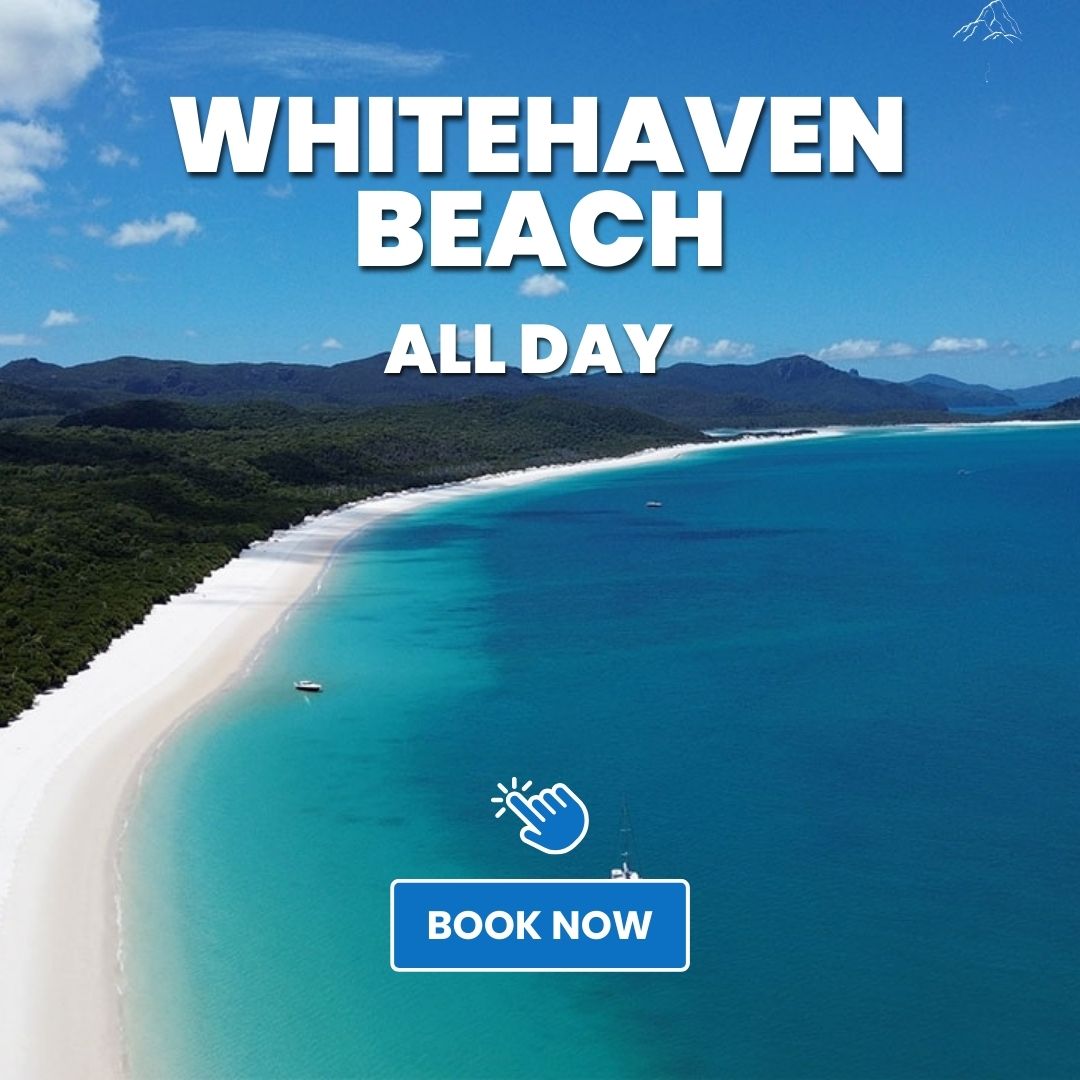
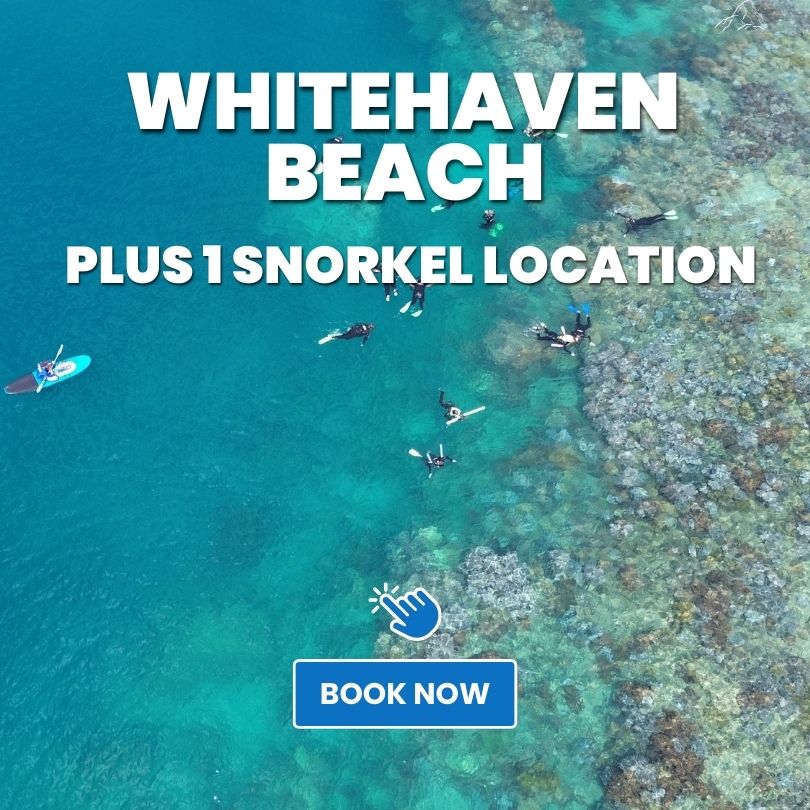

Latest Tour Pictures
Contact Us
Location

Nath J
Marketing Manager at ZigZag Whitsundays
Since 2017, I’ve been the Marketing Manager for ZigZag Whitsundays, and it’s been one massive journey. Over the years, I’ve helped grow the brand into one of the Whitsundays’ leading tour operators by focusing on what actually works: strong digital marketing, a solid direct bookings strategy, and smart connections with the right OTAs. With over 20 years in the tourism industry, I know this region inside and out and have always believed in prioritising our guests’ experience.
Certifications & Areas of Expertise
– Whitsundays Tourism Hero (QTIC)
– Respecting First Nations Cultural Protocols (QTIC)
– Tourism websites, SEO, and digital marketing
– Direct bookings & OTA integrations
ZigZag isn’t just another day tour; it’s a local family product I genuinely believe in. I’m proud to help market it, be part of its growth, and contribute to the wider Whitsundays community along the way.
